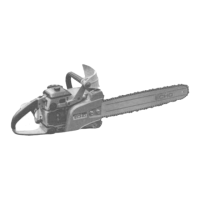
Do you have a question about the Echo CS-500VL and is the answer not in the manual?
| Chain Gauge | 0.050 in |
|---|---|
| Bar Length | 40 cm (16 in) |
| Chain Oil Capacity | 0.28 L |
| Fuel Capacity | 550 ml (18.6 oz) |
| Oil Tank Capacity | 0.28 L |
Step 1: Attaching the hand guard to the front handle assembly as illustrated.
Step 2: Inserting the appropriate component into the front handle.
Step 3: Connecting the hand guard holder with the insert and tightening securely.
Step 4: Inserting another component into the handle as shown in the diagram.
Step 5: Securing the pre-assembled front handle to the chainsaw mounts.
Covers essential safety rules for operating chain saws, including user training and fatigue.
Details important steps and checks to perform before starting chain saw operation, focusing on fuel and environment.
Guidance on stable footing, body posture, and pre-operation engine checks for safety.
Methods to avoid kickback and safe practices for cutting brush, limbs, and felling trees.
Specifies that complex chain saw servicing should be done by qualified personnel.
Lists key specifications for the engine, fuel mixture ratio, and tank capacities.
Details chain pitch, gauge, drive links, and guide bar types.
Lists various safety features like hand guards, chain catcher, and optional brake.
Diagram and labels identifying external parts of the ECHO CS-500VL chain saw.
Step-by-step instructions for correctly attaching the guide bar and saw chain.
Instructions for daily checks, fuel mixing, and lubrication before operating the saw.
Detailed steps for starting the chain saw engine when it is cold, including choke use.
Troubleshooting steps for when the engine is hard to start or won't start.
Procedures for operating the engine, acceleration, and safely stopping the chain saw.
Specific advice for diagnosing and resolving issues when the engine is difficult to start.
Steps for starting the chain saw engine when it is already warm.
Guidance on proper engine idling, acceleration, and safe stopping procedures.
Basic principles and safety practices for effective chain saw cutting.
Detailed steps for planning and executing safe tree felling operations.
Techniques for safely removing branches from a felled tree.
Instructions for adjusting and maintaining the carburetor for optimal performance.
Procedures for cleaning and maintaining the air filter.
Guidance on checking and cleaning the fuel strainer.
Steps for cleaning and maintaining the guide bar for longevity.
Guidelines for inspecting the sprocket for wear and when to replace it.
How to adjust the automatic oiler for proper chain lubrication.
Instructions for checking, cleaning, and gapping the spark plug.
Importance and method of cleaning cylinder fins for cooling.
Explains chain parts and the importance of keeping cutters sharp.
Describes the function of guard links in reducing kickback potential.
Identifies and explains the purpose of individual cutter components like top plate and depth gauge.
Details how the depth gauge controls cutting depth and its adjustment.
Practical guide on using files and file holders for sharpening chain cutters.
Illustrates correct angles for filing top plate, side plate, and depth gauge.
Explains how the chain brake stops chain motion during kickback events.
Procedure for adjusting the chain brake band when worn or elongated.
Diagnoses common reasons for engine starting problems, like fuel or spark issues.
Troubleshoots issues like poor acceleration, fuel leaks, and carburetor problems.
Identifies potential causes for the engine failing to crank, such as seized parts.
Addresses causes of engine overheating, like clogged cooling fins.
Diagnoses issues leading to low engine speed or chain not cutting effectively.
Troubleshoots problems related to incorrect chain tension, setting, or lubrication.
Steps for inspecting, cleaning, and oiling the saw for storage.
Instructions for draining fuel and preparing the engine for long-term storage.